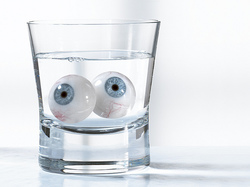
“Your eyes,” I asked. “Why do you take them out?”
Gillian laughed. “I guess the better question might be, ‘Why put them back in?’”
I’ve been working more on the novel I started last week. I’m now on the third chapter, about 7,500 words in total, and really like the progress.
Years ago, during one of his NPR book review segments, Alan Cheuse identified what he thought was the principle difference between novels and short stories. Short stories, Cheuse said, were all about images; novels, because of their longer page counts, were about the plots that propel the narrative. We can dicker. Most short stories rely, to varying degrees, on plot elements. Some of the very best images in American literature (I’m thinking, for example, of the eyes of Dr. T. J. Eckleburg that appear on a billboard in The Great Gatsby) are drawn from novels. And yet, one killer image in a ten-page short story might be enough to push that story to greatness.
Think of Ezra Pound’s two-line poem, “In a Station of the Metro”
The apparition of these faces in the crowd;
Petals on a wet, black bough.
Those two lines are the whole poem. Had they been stuck in the middle of an epic, slack-minded readers like myself would probably rush right past them, never giving them a second thought.
Having cut my literary teeth writing short stories, I’ve always paid an undue amount of attention in crafting my images. Whenever I’m lost, trying to figure out the direction the story will take, my artistic instincts direct me to craft an image of what the characters are seeing or touching. In some cases, I’d leap from image to image in lieu of crafting a narrative path. Which, to me, makes sense: once you “see” what a character sees (and how they see it), you get a sense of the character. As a writer, you draw the reader’s eye through the story, focusing on the things you feel are important.
Does this always work?
Not all the time.
The few lines that open this blog post—about Gillian and her eyes—have been with me for four or five years. I’m drawn to the opening image of the eyes in frosted glass jar, and the idea that someone might take out their eyes each night with the same ease and regularity as others take out their contact lenses. But, as much as I’ve picked at these lines over the years and tried to extend them into an actual story, my efforts continue to fail. In part, I think it’s because the main character (“Gillian”), having taken out her eyes, literally cannot see. Because she can’t see, as I writer I’ve boxed myself into a corner—I can’t portray what she “sees,” which is the principle means I often use to develop character.
In the past, when trying my hand at novels, I’ve continued to lean heavily on images and ideas at the expense of other fictive elements. It’s just how I’ve operated.
What’s neat though with the novel I started last week (see previous blog posts for a hint about this project), is that I’m not as beholden to images as I’ve been in the past. I’m excited by this, and eager to see where this takes me. The narrative is told through three first-person narrators and I’m much more concerned about voice and characterization than I’ve ever been before. Not coincidentally, so far my sentences are longer, richer, more detailed. And, because I’m trying to craft the novel as a domestic noir, I’m working harder to establish plot elements.
Addendum: Yesterday, at Entropy Magazine, a bunch of us (inc. myself) reminisced about our first loves. Please feel free to check out what we wrote.
PS: If anyone remembers the particular Alan Cheuse NPR review mentioned above, please contact me. I'd love to get a copy of that segment.
 RSS Feed
RSS Feed
